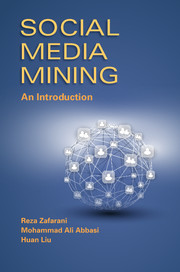1 - Introduction
Published online by Cambridge University Press: 05 July 2014
Summary
With the rise of social media, the web has become a vibrant and lively realm in which billions of individuals all around the globe interact, share, post, and conduct numerous daily activities. Information is collected, curated, and published by citizen journalists and simultaneously shared or consumed by thousands of individuals, who give spontaneous feedback. Social media enables us to be connected and interact with each other anywhere and anytime – allowing us to observe human behavior in an unprecedented scale with a new lens. This social media lens provides us with golden opportunities to understand individuals at scale and to mine human behavioral patterns otherwise impossible. As a byproduct, by understanding individuals better, we can design better computing systems tailored to individuals' needs that will serve them and society better. This new social media world has no geographical boundaries and incessantly churns out oceans of data. As a result, we are facing an exacerbated problem of big data – “drowning in data, but thirsty for knowledge.” Can data mining come to the rescue?
Unfortunately, social media data is significantly different from the traditional data that we are familiar with in data mining. Apart from enormous size, the mainly user-generated data is noisy and unstructured, with abundant social relations such as friendships and followers-followees. This new type of data mandates new computational data analysis approaches that can combine social theories with statistical and data mining methods. The pressing demand for new techniques ushers in and entails a new interdisciplinary field – social media mining.
Information
- Type
- Chapter
- Information
- Social Media MiningAn Introduction, pp. 1 - 10Publisher: Cambridge University PressPrint publication year: 2014
Accessibility standard: Unknown
Why this information is here
This section outlines the accessibility features of this content - including support for screen readers, full keyboard navigation and high-contrast display options. This may not be relevant for you.Accessibility Information
- 1
- Cited by
